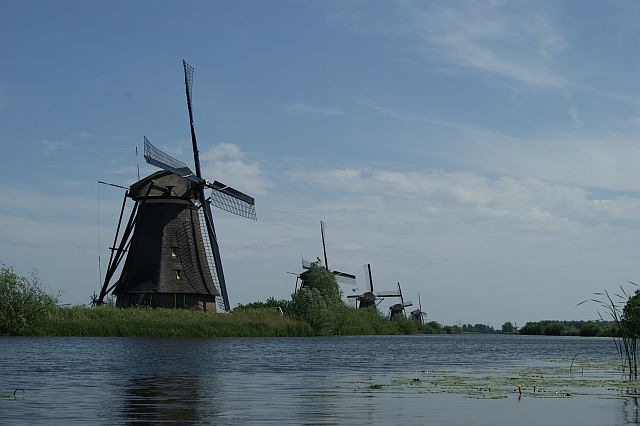What would be the Netherlands without their windmills? Certainly they beautifully animate montonously flat polder space, are a great tourist attraction and are the country’s most popular trademark. Once they worked hard, now they are in use one time a month or, if necessary, can support electronic pumps when water is high. Besides they decorate the landscape and serve sometimes as an apartment.
Dutch windmills were used not only for milling, but also for pumping out water and draining the soil. The most known and photographed ones are those from the Kinderdijk, the largest cluster of historic windmills in the Netherlands – they are on the UNESCO List of the World Cultural and Natural Heritage. Do you know that these devices have their own language?
Kinderdijk
Why do the Dutch need the pumping ones?
When the storms run across the North Sea and the waves attacks the coasts of the Low Countries, the locks to the North Sea close to protect the dikes and thus the land against the water.
However, from the mountains of central Europe, the rivers continue to supply water. That water cannot be discharged to the North Sea. So there is a moment when the (sweet) river water must flow into the countryside (the retention areas). When the currents are lurking, the water must enter the North Sea through the open locks. To this end, the rivers and channels must be pumped from flooded areas. Modern pumps need energy (diesel, gas or electricity). At that moment is the question if the infrastructure is still properly functioning so that a supply of these pumping stations is sufficient. The old-fashioned windmills do not need that energy! They can do without. There are still ca. 225 waterwind mills that can function. If they prove it (1 Saturday each month), the owner gets a grant. That costs a lot of tax money to sorrow from right-wing parties, but many of them are, this way, kept in a usable condition.
 Hendrik Avercamp “Winterlandscape with windmill”
Hendrik Avercamp “Winterlandscape with windmill”
Note:
Until the beginning of the 60-ties the switches and outlets for electricity had always to be mounted 1.50 from the floor so they were out of the reach of water when a dike gave up. Many houses had oillamps ready, just in case.
The language of the windmills
Many trees try to follow the sunlight during their growth. In the Netherlands the sun rises in the east, then draws south and goes down in the west. Growing trees try to follow that sun movement (a bit) and then get a bit of a spiraling fiber structure. This structure means that they are more stiff to a torsional load clockwise than by using them counter-clockwise. When using the trunk to make the main axle of a mill (whereon the wicks are stuck) it is wise to turn the mill wings counterclockwise so that shocks get dampened in the further grinding. Thus, the windmills are traditionally turning counter-clockwise. (Of course, in today’s metal constructions it is no longer necessary).
This way the usual direction of rotation of the mill is determined, so the positions of the wicks can be named. When the upper wick of a (stationary) mill is considered there are 12 positions available. The following 6 are quite common. The other possibilities are mainly determined regionally.
Picture from: Molens van Nederland (Herman Besselaar)
Without sails on the wicks:
1. Just before the highest point – position of happiness.
2. Right after the highest point – the sadness position.
3. At the highest point – the normal rest position
4. The diagonal position, the mill has no work for a longer time.
With sails on the wicks:
5. The diagonal position (with sails on the wicks), urgent help is needed (alarm).
Further signals with sail on the wicks are determined locally. (During the Second World War, the resistance in Holland used these possibilities to pass on signals).
With decorations on mill and wicks:
6. The mill does not work but celebrates happiness.
Further possibilities to decorate the wicks and mills are mainly in use in Frisia.
Notes:
* In position 2, the mill follows (faces) the sadness (i.c. a burial procession, etc.) while the church bell rings..
* In position 5, the mill faces the needed help (i.c. the carpenter or the like).
Unhappily the language of the mills is no longer known outside the polders. Below windmills from Ravenstein…
Lithoijen…
and Kinderdijk
See also: Kinderdijk
Han Tiggelaar
Photo: Dorota Mazur







